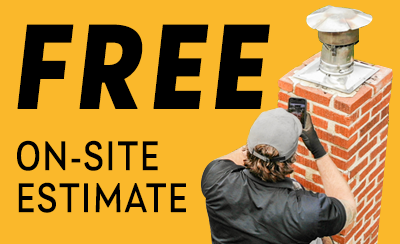A full chimney sweep and inspection of your chimney and fireplace is included in our chimney sweeps. We will inspect the exterior of the chimney, do a full sweep of the inside of the chimney and fireplace and then we use a camera to look at the inside of the chimney to make sure it is safe to use. We will give you an inspection report at the end and if we notice anything that needs work, we will give you an estimate for the repairs.
A typical cleaning can be over in as little as 30 minutes, but can go as long as an hour and a half. Nesting materia, if present, can take longer and may require a separate fee.
Yes, we can help you prevent future leaks, but doing these repairs will not undo existing stains. Felgemacher Masonry installs protective chimney covers and dampers. We seal crowns and also do chimney tuckpointing and rebuilding.
No, there will not be a mess during the chimney cleaning process. We put down drop cloths, wear shoe covers and our vacuums have HEPA filters. Our technicians strive to leave the area around the fireplace as clean or even cleaner than we found it.
Most chimneys and fireplaces can be cleaned from the bottom. We have specially designed tools made for this application. A typical sweeping will involve roof access for inspection of brick work, caps and flashing. Chimneys over 30 feet or hard to reach chimneys may not get inspected from the roof. This is typically left to the discretion of the technician.
Take a close look at the walls of your masonry chimney. Do you see cracks, crumbling bricks, uneven areas of mortar, voids, and noticeable gaps between the bricks? If the answer is yes or you're not sure call us to provide an estimate of the repair.
YES! Just because someone says a fireplace is “usable” does not mean that it is up to code. A NFPA Level-II inspection will identify potential problem areas, or give you peace of mind that the fireplace in your new home is in working order. It is always better to know up front than to be surprised later.
The whitish discoloration on the exterior of the furnace chimney is efflorescence. It is caused by the escape of gases through gaps in the liner. Felgemacher Masonry can make specific recommendations about installing a new liner and tuck pointing or rebuilding the chimney if necessary.
Vented gas logs require a fully functioning fireplace to be installed; the damper must be locked in an open position. Vented logs burn at a very low efficiency (less than 10%), requiring the logs to be vented to the outside. They burn up to 100,000 BTU’s and produce black soot on the logs.
Vent free gas logs operate at 99.9% efficiency (using technology similar to a gas range). Vent free logs burn gas clean, so venting to the outside is not required. Vent free gas logs burn up to 40,000 BTUS depending on room size. Vent free products are code approved, ANSI certified, and UL listed.
Vent free logs use the air in the room for combustion. As a result, anything released into the atmosphere of the room will be circulated through the vent free burner causing an odor. So always remember clean air in, clean air out – scented candles, air fresheners, carpet deodorizers and tobacco to name a few can all cause this problem. Dust and pet dander are also culprits to stinky logs. Getting annual service for vent free logs and burner is a great way to help eliminate odors and should always be performed by an NFI trained technician or someone familiar with vent free products.
 (CSIA) is a nonprofit organization governed by a volunteer board of directors dedicated to the education, training, and certification of chimney and industry related professionals. Additionally, they strive to advance public awareness about the dangers of chimney fires and other problems related to the maintenance and performance of chimney and venting systems. Since 1983, CSIA has been the industry leader in chimney and venting education. Our nationally recognized credentials include the CSIA Certified Chimney Sweep, CSIA Certified Dryer Exhaust Technician, and CSIA Master Chimney Sweep.
(CSIA) is a nonprofit organization governed by a volunteer board of directors dedicated to the education, training, and certification of chimney and industry related professionals. Additionally, they strive to advance public awareness about the dangers of chimney fires and other problems related to the maintenance and performance of chimney and venting systems. Since 1983, CSIA has been the industry leader in chimney and venting education. Our nationally recognized credentials include the CSIA Certified Chimney Sweep, CSIA Certified Dryer Exhaust Technician, and CSIA Master Chimney Sweep.



